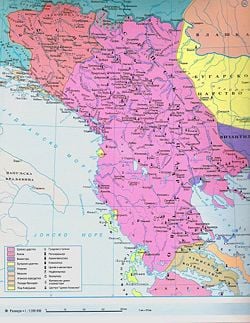Serbian Empire
| |||||||||||||||||||||||||||||||||||||
The Serbian Empire (Serbian: Српско Царство, Srpsko Carstvo) was a medieval empire in the Balkans that emerged from the medieval Serbian kingdom in the 14th century. The Serbian Empire existed from 1346 to 1371 and was one of the larger states in Europe.
History
Stefan Dusan, before he came to throne as king of serbia, proved himself as a very talented battle leader, who proved himself in war against Bulgaria, where Serbia heavily defeatet the Bulgarian kingdom. As his father wasn't really an able conqueror, Dusan, with the help of Serbian nobility, removed his father from the throne, ordering his people to strangle him. The medieval Serbian state reached its apex in the mid-14th century, during the rule of Stefan Dušan, who proclaimed himself in 1345 emperor (tsar) in Serres and was solemnly crowned in Skopje on April 16 1346 as "Tsar and autocrat of Serbs and Greeks" by the newly created Serbian Patriach Joanikie II with the help of the Bulgarian Patriarch Simeon and the Archbishop of Ohrid, Nicholas.
Stefan Dušan also introduced Dušanov Zakonik (Dušan's Code, 1349), a juridical achievement unique among the European states of the time. Emperor Dušan opened up new trade routes and strengthened the state's economy. Serbian Empire flourished, featuring one of the most evolved countries and cultures in Europe. Some of Serbia's greatest Medieval arts were created during this period, most notably St. Sava's Nomocanon.
Emperor Stefan Dušan doubled the size of his former kingdom, seizing territories to the south, southeast and east at the expense of Byzantium. He was succeeded by his son Uroš, called the Weak, a term that might also apply to the state of the empire, as it slowly slid into feudal anarchy. This is a period marked by the rise of a new threat: the Ottoman Turk sultanate gradually spreading from Asia to Europe and conquering Byzantium first, and then the other Balkans states. Too incompetent to sustain the great empire created by his father, Uroš could neither repel attacks of foreign enemies, nor combat the independence of his nobility. The Serbian Empire of Stefan Uroš fragmented into a conglomeration of principalities, some of which did not even nominally acknowledge his rule. Stefan Uroš V died childless in December 1371, after much of the Serbian nobility had been destroyed by the Turks in the Battle of Marica earlier that year.
Emperors
- Stefan Uroš IV Dušan of Serbia (1346-1355)
- Stefan Uroš V of Serbia (1355-1371)
See also
- History of Serbia
bg:Сръбско царство it:Impero serbo nl:Keizerrijk Servië ru:Сербское царство sr:Српско царство tr:Sırp İmparatorluğu zh:塞尔维亚帝国
Credits
New World Encyclopedia writers and editors rewrote and completed the Wikipedia article in accordance with New World Encyclopedia standards. This article abides by terms of the Creative Commons CC-by-sa 3.0 License (CC-by-sa), which may be used and disseminated with proper attribution. Credit is due under the terms of this license that can reference both the New World Encyclopedia contributors and the selfless volunteer contributors of the Wikimedia Foundation. To cite this article click here for a list of acceptable citing formats.The history of earlier contributions by wikipedians is accessible to researchers here:
The history of this article since it was imported to New World Encyclopedia:
Note: Some restrictions may apply to use of individual images which are separately licensed.

